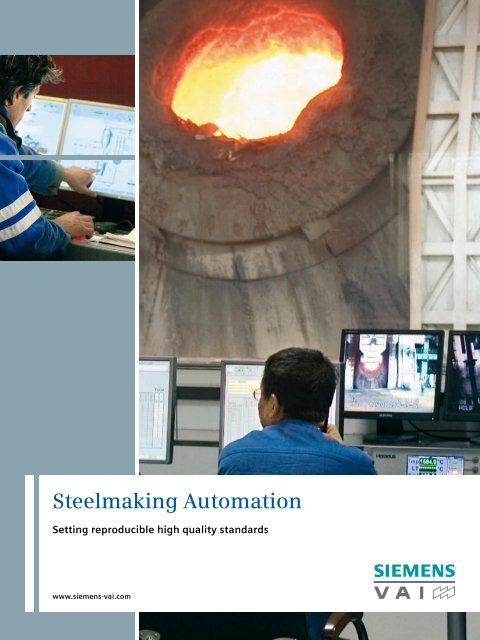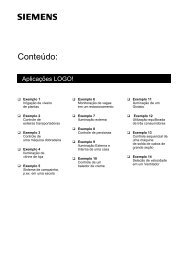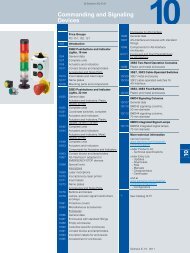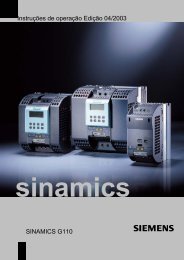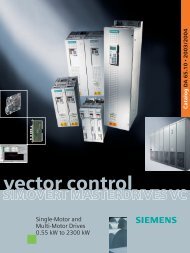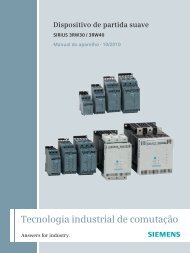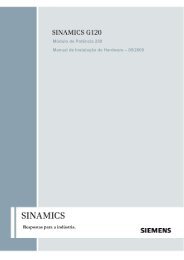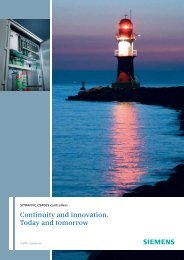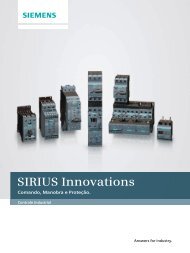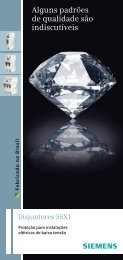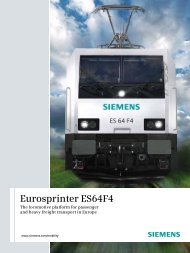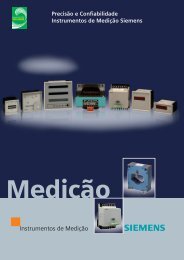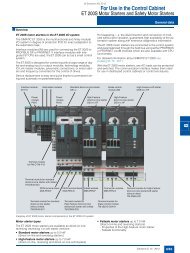Steelmaking Automation - Siemens
Steelmaking Automation - Siemens
Steelmaking Automation - Siemens
Create successful ePaper yourself
Turn your PDF publications into a flip-book with our unique Google optimized e-Paper software.
<strong>Steelmaking</strong> <strong>Automation</strong><br />
Setting reproducible high quality standards<br />
www.siemens-vai.com
<strong>Automation</strong> expertise<br />
Completely integrated solutions for steelmaking plants<br />
The challenge:<br />
In the booming metals market steel producers<br />
meet capacity limits, while demands<br />
on products and processes are<br />
ever increasing: Customers, such as the<br />
automotive industry, permanently ask for<br />
enhanced chemical and physical steel<br />
properties. Top grade steel quality is in<br />
high demand and absolutely crucial for<br />
entering high-margin market segments.<br />
As a result, steel plants have to operate<br />
at an extremely high efficiency and availability<br />
to produce the required quantities.<br />
As a consequence of globalization, many<br />
steel producers operate globally, and that<br />
requires greater expenses for coordination<br />
and a high degree of transparency.<br />
The requirements described above must<br />
be met in order to ensure a competitive<br />
edge for your steel plant. Entire production<br />
routes, that may even be linked globally,<br />
have to be optimized. Achievement<br />
of a sustainable profit life-cycle management<br />
of the applied technology and solutions<br />
is a must.<br />
Our solutions:<br />
<strong>Steelmaking</strong> today is unthinkable without<br />
sophisticated automation. <strong>Siemens</strong> VAI<br />
automation systems, based on decades of<br />
combined engineering, plant-building,<br />
operational, metallurgical and automation<br />
experience, are the key to high-tech<br />
steelmaking for high quality products at<br />
low production costs. These systems<br />
include:<br />
<br />
<br />
<br />
<br />
<br />
<br />
Completely integrated solutions for the<br />
entire iron and steel production route<br />
Both integrated and stand-alone solutions<br />
for all automation levels<br />
Modular-designed, expandable and<br />
upgradeable automation packages<br />
In-house experience in software and<br />
hardware engineering for fastest<br />
project implementation and start-up<br />
Solution-oriented service for all stages<br />
of the project, from feasibility studies<br />
to start-up and client training<br />
Unique features include the optimized<br />
“plug and play” SIMATIC components<br />
which are linked to the controllers and<br />
models for continuous optimization of<br />
the process, along with the flexibility to<br />
add or exchange these in the plant
Good reasons for <strong>Siemens</strong> VAI steelmaking automation<br />
Integrated automation solutions for constantly high, reproducible steel quality<br />
<br />
<br />
<br />
Comprehensive, consistent operator guidance and process information throughout<br />
the complete steel production route<br />
Standardized production operations yielding homogenous steel quality that fulfils<br />
certification requirements<br />
Increased productivity through optimized steel melting and refining processes for<br />
shorter treatment durations<br />
Minimized production costs using process models for optimized material usage and<br />
energy input
Advanced systems for maximized benefits<br />
Experience makes the difference<br />
Leading automation solutions …<br />
<strong>Siemens</strong> VAI steelmaking automation<br />
<strong>Siemens</strong> VAI steelmaking automation<br />
supplies state-of-the-art solutions for<br />
maximum performance and product<br />
quality throughout the entire steel plant.<br />
The unique advantage of this integrated<br />
approach is that it covers the aspects of<br />
process stability, product quality and<br />
operation flexibility, while safeguarding<br />
efficiency and profitability throughout<br />
the entire plant life-cycle.<br />
Decades of experience with steelmaking<br />
technology, combined with extensive automation<br />
expertise, is the basis for highly<br />
advanced automation systems for every<br />
plant unit. Proven solutions for power<br />
supply, drives, technological packages<br />
and process optimization enable smooth<br />
production and the intelligent use of<br />
energy and raw materials. And forwardlooking<br />
service concepts ensure continuous<br />
high availability of plant and<br />
equipment.<br />
Your investment is protected by our standardized<br />
overall design with clear-cut<br />
interfaces. As a plant operator, you can<br />
absolutely rely on <strong>Siemens</strong> VAI steelmaking<br />
automation, including upgrading or<br />
expanding automation scenarios as well.
ERP<br />
MES<br />
<strong>Automation</strong><br />
Power, drives and infrastructure<br />
Process<br />
… on all plant levels for each steel production unit<br />
Process optimization models<br />
SteelExpert is the comprehensive group<br />
of process models that perfectly images<br />
and optimizes the process of steelmaking<br />
in different production units.<br />
SteelExpert Supervision, a set of online<br />
models, is monitoring the metallurgical<br />
and thermal process, cyclically calculates<br />
the actual condition of steel bath and<br />
slag. This provides the analysis and temperature<br />
of steel bath and slag at any<br />
time and setpoint model calculations are<br />
always based on the actual situation.<br />
The extensive group of setpoint models<br />
results in SteelExpert Setpoint, which is<br />
responsible for determining the required<br />
supplies of raw materials, gas volumes<br />
and/or energy for different treatment<br />
steps.<br />
SteelExpert Prediction performs a simulation<br />
of the complete production process<br />
– using the results of supervision and setpoint<br />
models. It provides a forecast of the<br />
progress and the final condition of the<br />
heat, it also predicts all required additions<br />
and actions and serves to optimize<br />
the production process.<br />
Whereas the models are adjusted specifically<br />
to the special requirements at different<br />
production units, the principle of<br />
SteelExpert combining the features of<br />
prediction, supervision and setpoint models<br />
for perfect quality is applied throughout<br />
the entire steelmaking automation.<br />
VAI-Q Steel<br />
<strong>Siemens</strong> VAI provides automated quality<br />
control systems for the entire steel production<br />
route under the family name VAI-Q.<br />
VAI-Q Steel interacts seamlessly with the<br />
<strong>Siemens</strong> VAI process models and guides<br />
the operators step by step through steelmaking<br />
and refining. Starting from a simulation<br />
for the planned production route,<br />
it dynamically reacts to changing production<br />
situations and adapts the required<br />
treatment actions based on the current<br />
situation.<br />
Comprehensive quality information, as a<br />
guide for the operators, is displayed in<br />
the individual pulpits as part of the process<br />
computer screens. The decisions of<br />
the system are based on an integral view<br />
of the entire steelmaking and refining<br />
process.
LD (BOF) converter automation<br />
Intelligent solutions to conquer the market<br />
1st hot metal charging at Jiangsu Shagang, Zhangjiagang, China<br />
LD (BOF) process control<br />
<strong>Siemens</strong> VAI automation solutions for<br />
process control (level 1) cover the entire<br />
LD (BOF) steelmaking process, including:<br />
Oxygen lance control system<br />
Converter tilting drive<br />
Sublance measuring system<br />
Bottom stirring – single line control<br />
Additive and alloy weighing and control<br />
Waste gas cooling and cleaning<br />
Gas recovery and analyzing<br />
Slopping prevention system<br />
Secondary dedusting<br />
Interlocking and alarm system<br />
Human machine interface<br />
<br />
Bottom stirring<br />
Bottom stirring using inert gas offers<br />
advantages in metallurgical and operational<br />
aspects. In particular, the process<br />
kinetics are significantly improved and<br />
the decarburization reaction at low<br />
carbon content is forced.<br />
Individual gas flow control offers an optimum<br />
of working safety and operational<br />
convenience:<br />
<br />
<br />
<br />
Uniform distribution of the gas flow<br />
among each stirring element ensures<br />
an even cooling effect and thus prevents<br />
a different wear behavior of individual<br />
stirring elements.<br />
Failure of a stirring element is compensated<br />
by those stirring elements still in<br />
operation, so that a constant efficiency<br />
of the bottom stirring process is<br />
maintained.<br />
Reading of gas flow and gas pressure<br />
as well as indication of valve positions<br />
allows a permanent control of each<br />
stirring element.<br />
Main benefits:<br />
Yield increase of more than 1 %<br />
<br />
<br />
Fast and accurate adjustment of tapping<br />
temperature<br />
Reducing the carbon content to 0.02 %<br />
without the need of vacuum treatment<br />
Lower phosphorous and oxygen levels<br />
Reduced flux quantities (more than 10 %)<br />
Tolerance to a wide range of hot metal<br />
compositions<br />
Bottom injection of inert gas for<br />
best perfomance and a long life
Bottom stirring process control<br />
Pneumatic slag stopper for more cost savings<br />
Sublance system<br />
The sublance system is used for measuring<br />
temperature, carbon content and oxygen<br />
activity of the steel bath, as well as<br />
for taking steel samples without the need<br />
to interrupt the oxygen blow.<br />
Instrumentation and drives ensure excellent<br />
position accuracy and operational<br />
safety. Closed-loop process control of the<br />
sublance allows fully automatic in-blow or<br />
end-of-blow measurements.<br />
The process optimization model<br />
SteelExpert dynamically supervises and<br />
controls the oxygen blowing process<br />
based on the in-blow measurement.<br />
By determining the ideal blow-end-point,<br />
significant operational savings and improvement<br />
of productivity are obtained.<br />
Main benefits:<br />
Reduced charge to tap time<br />
Improved hitting rate<br />
Increased iron yield<br />
Reduced oxygen consumption<br />
The sublance, a central part of<br />
dynamic process control<br />
Pneumatic slag stopper<br />
In order to avoid carry-over slag from the<br />
converter getting into the ladle at the end<br />
of tapping, a cast iron nozzle is slewed<br />
into the tap hole from the outside<br />
through which retaining gas is blown.<br />
Sealing is performed pneumatically and<br />
thus not influenced by irregular tap hole<br />
wear and slag consistency. Reliable sealing<br />
can be done with any type of slag.<br />
Slag detection and actuation of the slag<br />
stopper in regular operation is made automatically<br />
by means of the “IRIS” (infrared<br />
indication of slag) system. This system<br />
evaluates the infrared radiation differences<br />
of steel and slag, respectively,<br />
which are recorded by an infrared camera.<br />
Main benefits:<br />
Lower cost of deoxidation agent<br />
Higher ferro alloy yield<br />
Lower refractory consumption<br />
Lower rephosphorization rate<br />
Less inclusions
LD (BOF) process optimization<br />
Maximized performance through dynamic modeling<br />
Dynamic supervision of blowing process<br />
LD (BOF) converter automation<br />
<strong>Siemens</strong> VAI automation for LD (BOF)<br />
steelmaking not only considers the<br />
vessel-specific process functions, but also<br />
takes into account the relevant parameters<br />
of the charging materials, including<br />
hot metal preparation, scrap yard management<br />
and scheduling logistics.<br />
Process optimization (level 2) solutions<br />
are based on advanced algorithmic equations,<br />
which accurately represent the<br />
complex thermodynamic-metallurgical<br />
reactions. The solutions are particularly<br />
suitable for a wide range of operating<br />
conditions, e.g. variable scrap to hot<br />
metal ratios, minimum slag practice and<br />
varying phosphorus content.<br />
Dynamic process models<br />
<br />
<br />
<br />
Based on the hot metal weight, analysis<br />
and temperature, SteelExpert HM<br />
Desulph calculates the necessary material<br />
type and weight for achieving the<br />
desired sulphur content in the hot<br />
metal.<br />
SteelExpert Prediction simulates the<br />
complete LD (BOF) process before the<br />
heat is actually started and determines<br />
the optimum blowing and stirring strategy,<br />
as well as the exact time and portioning<br />
of vessel additions.<br />
Taking into account the hot metal temperature<br />
and analysis, SteelExpert FCC<br />
(first charge calculation) determines<br />
the required quantities of different<br />
scrap types, as well as the amount of<br />
hot metal to be charged to the<br />
LD (BOF) vessel.<br />
<br />
<br />
<br />
Based on the actual data of hot metal<br />
and scrap charged to the LD (BOF)<br />
vessel, SteelExpert SCC (second charge<br />
calculation) automatically calculates<br />
the required oxygen volume and vessel<br />
additions to achieve the desired steel<br />
quality.<br />
SteelExpert Inblow uses the information<br />
from a sublance measurement for<br />
a refinement of SteelExpert SCC by a<br />
calculation of heating/cooling agents<br />
and remaining oxygen for an improved<br />
hitting rate.<br />
SteelExpert Reblow is applied in the<br />
rare event of necessary reblowing. It<br />
determines the required oxygen volume<br />
and vessel additions for various<br />
reblowing reasons.<br />
SteelExpert Alloy determines the types<br />
and amount of alloying materials to be<br />
added during tapping in a cost-optimized<br />
way.
LD (BOF) pulpit at Taiyuan ISCO, China<br />
<br />
<br />
SteelExpert Supervision cyclically calculates<br />
the actual condition of steel bath<br />
and slag from charging end to tapping<br />
start.<br />
DYNACON<br />
If a continuous off-gas measurement<br />
(analysis and flow) is available,<br />
DYNACON is applied as a supplement<br />
for SteelExpert Supervision. It dynamically<br />
calculates the optimum moment<br />
for blow end to achieve the target carbon<br />
content of the steel from the offgas<br />
information. Thus DYNACON is<br />
saving valuable time due to the uninterrupted<br />
blowing process and therefore<br />
unimpaired decarburization rate. The<br />
combination of the supervision model<br />
and DYNACON is a convincing approach<br />
for increasing carbon and temperature<br />
hitting rates with low investment,<br />
maintenance and operational expenses.<br />
A proven solution for off-gas measurement<br />
is LOMAS®, which carries out continuous<br />
gas analysis during the combustion<br />
process at high temperatures and<br />
dust loads, and in corrosive and reducing<br />
environment conditions. The analysis<br />
from the installed mass spectrometer is<br />
transmitted in two-second intervals and<br />
directly utilized in the dynamic process<br />
control.<br />
References<br />
Nanjing ISCO, China<br />
Taiyuan ISCO, China<br />
US-Steel Kosice, Slovakia<br />
Maanshan ISCO, China<br />
<br />
Mittal Steel Vanderbijlpark,<br />
South Africa<br />
Main benefits:<br />
<br />
<br />
Temperature deviation reduced<br />
by 40 %<br />
Carbon deviation reduced<br />
by 45 %<br />
Reblow rate reduced by up to 60 %<br />
Increase in production by up to 10 %
EAF automation<br />
Power under control in carbon and stainless steelmaking<br />
Making the most efficient use of electrodes – with our fully automatic electrode control system<br />
EAF process control<br />
EAF process control<br />
A modern and powerful process control<br />
system assures a safe and user-friendly<br />
plant operation even under difficult conditions.<br />
It provides high reliability and<br />
availability to pave the path for a smooth<br />
process.<br />
The <strong>Siemens</strong> VAI automation solution,<br />
based on the SIMATIC PCS7 combines the<br />
advantages of PLC-based automation<br />
systems – such as proven quality and stability,<br />
low hardware costs, fine-grained<br />
scalability, reliable process control, userfriendly<br />
operation, clear visualization and<br />
powerful engineering tools – with specific<br />
technology solution packages that<br />
are tailored to the customer needs.<br />
In order to comply with the special<br />
requirements of the iron and steel<br />
industry, special software modules and<br />
typical software solutions are used. These<br />
standard modules, which can be retrieved<br />
as tested function units from a software<br />
library, further increase productivity.<br />
The structuring with uniform system<br />
tasks contributes to increased process<br />
reliability and high operating efficiency.<br />
The <strong>Siemens</strong> VAI basic automation uses<br />
high-speed microprocessor based systems<br />
for technological controls and sequential<br />
controls. The automation system<br />
is divided into several automation units,<br />
which are coordinated to execute the<br />
required tasks. Each automation unit is<br />
connected to the associated electrical<br />
periphery (generally using remote IO<br />
connection) for sensoring and actuating.<br />
The task of the operating and monitoring<br />
system (HMI Human Machine Interface)<br />
is the preparation of the increasing quantity<br />
of information about the process in a<br />
way that the operator receives a clear and<br />
easy-to-understand representation of the<br />
plant. The HMI system supports a simple<br />
and systematic operation of the electric<br />
arc furnace.<br />
Fully automatic electrode control<br />
<strong>Siemens</strong> VAI provides a fully automatic,<br />
end-to-end solution for electrode control<br />
in three-phase electric arc and ladle furnaces.<br />
It regulates and dynamically adjusts<br />
the electric arc and makes the most<br />
efficient use of electrodes.<br />
The solution relies on artificial intelligence<br />
to optimize the melting process.<br />
It also includes an optional meltdown<br />
control module with melting programs to<br />
ensure accurate reproduction of the melting<br />
process to ensure maximum furnace<br />
productivity.<br />
The electrode control and its add-on units<br />
are based on our proven SIMATIC S7 technology;<br />
they can be integrated into any<br />
system environment and architecture.<br />
This technology has been successfully<br />
used in more than 300 applications<br />
worldwide.<br />
10
Foaming slag monitor<br />
Main benefits:<br />
<br />
<br />
<br />
<br />
<br />
Dynamic control parameters and reduced<br />
energy consumption for melting<br />
performance and more efficient use of<br />
resources<br />
Higher productivity and reduced stoppage<br />
times through fast electrode removal<br />
and automatic remelting<br />
programs<br />
Graphic input and display of all control<br />
parameters<br />
Extended furnace life by preventing<br />
furnace hot spots<br />
Amortization within less than six<br />
months<br />
Foaming slag manager<br />
A sensor system based on structure-born<br />
noise is the new approach to evaluate the<br />
amount of foaming slag in the electric arc<br />
furnace. In regards to trends and reproducibility,<br />
this method has proved to successfully<br />
follow the real foaming slag situation<br />
in the arc furnace.<br />
Three structure-born noise sensors, each<br />
assigned to one electrode segment, are<br />
used to record vibration signals. The<br />
foaming slag level is calculated based on<br />
the combination of structure-born noise<br />
and current signals.<br />
With the detection method, operating<br />
personnel are in a better position to check<br />
the quality and reproducibility of process<br />
control in the foaming slag phase with a<br />
high degree of accuracy. The process can<br />
be optimized with regard to stability, process<br />
time and power consumption on this<br />
basis.<br />
The system also offers a reliable basis<br />
for closed-loop foaming slag control<br />
based on exactly determining the slag<br />
level and supplies signals for triggering<br />
the carbon/oxygen lances or coherent<br />
burners installed in the furnace.<br />
Main benefits:<br />
<br />
<br />
<br />
Multi-dimensional spatial recording of<br />
the foaming slag over the time<br />
Real time control of burners and injection<br />
devices based on actual melting<br />
conditions<br />
Shortened tap-to-tap time through optimized<br />
formation of foaming slag<br />
11
EAF process optimization<br />
Improved performance for higher profit<br />
Optimized melting profile with SteelExpert<br />
EAF automation<br />
<strong>Siemens</strong> VAI automation solutions in EAF<br />
steelmaking are ideal for new as well as<br />
existing plants of any size, regardless of<br />
the furnace supplier. They optimize production<br />
of a wide range of steel grades,<br />
including carbon steels, stainless steels<br />
and special steels while accommodating<br />
variable charging ratios of scrap, DRI<br />
(Direct Reduced Iron) and hot metal.<br />
This leads to fewer steel treatment correction<br />
steps, a minimum number of<br />
downgraded heats and exact adherence<br />
to tight production schedules as the basis<br />
for just-in-time delivery to downstream<br />
processing plants.<br />
Dynamic process models<br />
<br />
<br />
<br />
<br />
SteelExpert Prediction for EAFs performs<br />
a precalculation of the complete<br />
heat, tracing the defined melting practice.<br />
It gives a preview of the melting<br />
process and steel condition at tapping<br />
and automatically adjusts power profile<br />
and material additions to optimize the<br />
process.<br />
SteelExpert Charge is the setpoint<br />
model for proper scrap bucket loading.<br />
The cost optimizing calculation selects<br />
the scrap types and determines the required<br />
quantities as well as the total<br />
amount of DRI to be added.<br />
SteelExpert Slag determines the slag<br />
forming agents with respect to a given<br />
minimum slag mass and aim basicity.<br />
SteelExpert Alloy calculates the costoptimized<br />
quantities of alloying additives<br />
for the furnace or the tapping<br />
ladle.<br />
<br />
<br />
<br />
SteelExpert Temp determines the<br />
amount of electrical energy necessary<br />
for melting the prepared and charged<br />
materials and for heating the steel bath<br />
up to tapping temperature, considering<br />
the energy input from blown oxygen.<br />
For stainless steel production,<br />
SteelExpert Reduction calculates the<br />
necessary amount of FeSi for reduction<br />
of oxides from the slag.<br />
For furnaces with continuous DRI feeding<br />
facilities, DRI Feed Rate Control<br />
dynamically controls the DRI feed rate<br />
targeting a constant steel temperature,<br />
taking into account the DRI<br />
temperature.<br />
Power Demand Control provides on-line<br />
monitoring of power consumption and<br />
transmission of predicted power consumption<br />
targeting the prevention of<br />
peak loads and high tariff rates.<br />
12
EAF pulpit at Carinox, Charleroi, Belgium<br />
Main benefits:<br />
<br />
<br />
<br />
<br />
Reduction of tap-to-tap time by<br />
up to 10 %<br />
Reduction of energy consumption by<br />
up to 5 %<br />
Reduction of alloying material costs by<br />
up to 5 %<br />
Reduced energy costs by avoiding peak<br />
tariff rates<br />
References<br />
<br />
Edelstahlwerke Südwestfahlen,<br />
Siegen, Germany<br />
Taiyuan ISCO, China<br />
Carinox, Charleroi, Belgium<br />
Outokumpu Stainless, Tornio, Finland<br />
<br />
Rocky Mountain Steel Mills,<br />
Pueblo, USA<br />
EAF scrap charging<br />
13
Stainless steelmaking converter automation<br />
Refining the quality of steel<br />
AOD converter at Carinox, Charleroi, Belgium<br />
Stainless steel converter automation<br />
<strong>Siemens</strong> VAI solutions for stainless steel<br />
converters cover the complete range of<br />
available refining technologies, such as<br />
AOD and K-OBM-S. Intelligent control of<br />
the converter process is performed by the<br />
application of a number of dynamic process<br />
models.<br />
The automation solutions focus on ensuring<br />
an optimum metallurgical and process<br />
technological performance with<br />
respect to steel quality and operational<br />
costs.<br />
Dynamic process models<br />
<br />
<br />
<br />
<br />
<br />
To assure top quality stainless steel production,<br />
SteelExpert Prediction simulates<br />
the complete AOD process before<br />
the heat is actually started using various<br />
setpoint models:<br />
SteelExpert Alloy calculates a costoptimized<br />
mixture of alloying materials<br />
and scraps to reach the target analysis<br />
and weight of the steel bath.<br />
SteelExpert Slag calculates a mixture of<br />
slag forming additions to reach optimal<br />
slag basicity for the AOD process.<br />
SteelExpert Decarb determines the necessary<br />
blowing volumes and flows for<br />
various decarburization steps.<br />
SteelExpert Reduction finally calculates<br />
the amount of reduction agents and<br />
the necessary process time for complete<br />
reduction of the slag.<br />
<br />
In addition to online tracking of the<br />
complete steel and slag condition during<br />
the entire AOD process, SteelExpert<br />
Supervision automatically optimizes<br />
the duration of the decarburization<br />
steps, based on the actual process information<br />
from level 1 and on sample<br />
or measurement data.<br />
In the rare case when correction measures<br />
are necessary, a set of additional<br />
setpoint models is available:<br />
<br />
For desulphurization in two-slag practice,<br />
SteelExpert Desulph determines<br />
the required material weights for the<br />
intermediately deslagged steel bath.<br />
SteelExpert Reblow can be started for<br />
various reasons to correct the steel<br />
temperature and/or analysis. The necessary<br />
addition materials and gas volumes<br />
are determined based on sample<br />
data or measurements.<br />
14
AOD online model display<br />
<br />
During final adjustment the steel<br />
weight, temperature and analysis can<br />
be accurately adapted to the planned<br />
steel quality by the addition of alloying<br />
materials and/or scraps according to the<br />
specification of SteelExpert Adjust.<br />
Main benefits:<br />
Improved and assured steel quality<br />
<br />
15 % reduction of process gases and<br />
reduction agents<br />
10 % decrease of refractory costs<br />
<br />
Increase of productivity up to 1 heat<br />
per day<br />
References<br />
Taiyuan ISCO, China<br />
Carinox, Charleroi, Belgium<br />
Böhler Edelstahl, Kapfenberg, Austria<br />
Ugine & ALZ, Genk, Belgium<br />
Acesita, Belo Horizonte, Brazil<br />
Process supervision with SteelExpert<br />
15
Secondary metallurgy automation<br />
Excellent solutions for premium steel quality<br />
VOD plant at Wuyang Steel, China<br />
RH vacuum degassing<br />
Secondary metallurgy automation<br />
In order to satisfy the requirements for<br />
high product quality and lowest production<br />
costs, final adjustments in steel<br />
chemistry and temperature are carried<br />
out in secondary metallurgical facilities.<br />
Meeting narrow tolerances and a fully automatic<br />
production sequence from steelmaking<br />
to casting is only possible with<br />
the support of sophisticated automation<br />
systems. Depending on required steel<br />
grade and quality demands, <strong>Siemens</strong> VAI<br />
automation systems handle all types of<br />
process variants and operational procedures<br />
for ladle treatment facilities and<br />
furnaces, as well as vacuum degassing<br />
plants.<br />
For exact coordination of secondary<br />
metallurgical and continuous casting<br />
operations, especially for meeting the<br />
requirements of sequence casting, the<br />
heat pacing function can be applied.<br />
Dynamic process models<br />
<br />
<br />
<br />
The precalculation model – SteelExpert<br />
Prediction, previews the theoretic<br />
course of the complete treatment and<br />
automatically adapts the treatment<br />
practice to the heat-specific requirements.<br />
Depending on the plant’s technical<br />
equipment, the model optimizes<br />
the scheduled treatment steps and inserts<br />
additional actions if necessary.<br />
SteelExpert Alloy, SteelExpert Deox,<br />
SteelExpert Desulph and SteelExpert<br />
Shape calculate the materials to be<br />
added during the different treatment<br />
steps for final adjustment of the steel<br />
analysis on a cost-optimized basis.<br />
SteelExpert Temp calculates the energy<br />
required for reaching the target steel<br />
bath temperature and thereby defines<br />
the appropriate duration of electrical or<br />
chemical heating. In the opposite case,<br />
Steel Expert Cooling supplies a setpoint<br />
for the amount of cooling agent<br />
necessary.<br />
<br />
<br />
<br />
For vacuum degassing plants equipped<br />
with an oxygen blowing lance,<br />
SteelExpert Oxygen calculates the total<br />
amount of oxygen needed for forced<br />
decarburization.<br />
If stainless steel is finalized in the vacuum<br />
degassing plant (VOD), SteelExpert<br />
Reduction is applied for an optimized<br />
reduction phase.<br />
For vacuum degassing SteelExpert<br />
Supervision additionally controls the<br />
removal of hydrogen, nitrogen, oxygen<br />
and carbon from the steel bath according<br />
to the vacuum level and the metallurgical<br />
treatment.<br />
16
SteelExpert for secondary metallurgy<br />
Main benefits:<br />
<br />
<br />
<br />
Reduction in energy costs by<br />
up to 3 %<br />
Reduction in alloying material costs by<br />
up to 10 %<br />
Reduction in treatment time by<br />
up to 5 %<br />
Elimination of return heats<br />
References<br />
Taiyuan ISCO, China<br />
Lechstahlwerke, Meitingen, Germany<br />
<br />
Edelstahlwerke Südwestfahlen,<br />
Siegen, Germany<br />
Carinox, Charleroi, Belgium<br />
Usiminas, Ipatinga, Brazil<br />
Wuyang Steel, China<br />
Ladle furnace at Carinox, Charleroi, Belgium<br />
17
Expertise based on experience<br />
Selected success stories with steelmaking automation<br />
Competence in figures. Especially in the field of steel automation, where increased productivity,<br />
higher capacity, lowered operating costs and reducing emissions count more than<br />
anything. These are results with which our customers can measure their success – and ours<br />
as well. Have a closer look, and you can judge us by these examples of successful projects.<br />
Customer:<br />
Carbon and stainless steelmaking under one roof<br />
Taiyuan ISCO, China<br />
<strong>Automation</strong> for: 2 x LD (BOF) converter, 2 x EAF, 2 x AOD converter, 2 x Twin LF, 1 x RH plant<br />
Our solution:<br />
The result:<br />
Integrated automation systems for complete carbon and stainless steel production lines in the new<br />
steelmaking plant no. 4 at Taiyuan, including electrical equipment and instrumentation, process<br />
control and optimization.<br />
Standardized production operations for constantly high and reproducible quality in steel.<br />
Full automation functionality right from the first heat assures comprehensive operator guidance and<br />
process information throughout the entire production routes. Process optimization models assure<br />
maximum productivity and high hitting rates with minimum material costs and energy consumption.<br />
18
Customer:<br />
Improved steel quality at reduced production cost<br />
Mittal Steel Vanderbijlpark, South Africa<br />
<strong>Automation</strong> for: 3 x LD (BOF) converter, hot metal desulphurization, 2 x LF, 1 x argon station,<br />
1 x RH plant<br />
Our solution:<br />
The result:<br />
New process optimization system for existing oxygen steelmaking plant.<br />
Analysis and temperature values meet the target performance figures,<br />
whereas raw material costs for converter additions and alloying materials<br />
and expenses for temperature probes were significantly reduced.<br />
Customer:<br />
Comprehensive automation for stainless steel meltshop<br />
Carinox Ugine & ALZ Group, Arcelor, Charleroi, Belgium<br />
<strong>Automation</strong> for: 1 x EAF, 1 x AOD converter, 1 x LF<br />
Our solution:<br />
The result:<br />
Integrated automation systems for new stainless steel meltshop, including<br />
electrical equipment, instrumentation, process control and optimization.<br />
Uniform automation systems of all levels and uniform HMI throughout<br />
the entire production route, optimized stainless steel production, through<br />
advanced tracking and prediction methods.<br />
Customer:<br />
Competitive EAF steelmaking with process optimization<br />
Edelstahlwerke Südwestfalen, Siegen, Germany<br />
<strong>Automation</strong> for: 1 x EAF, 2 x LF, 1 x RH plant, 2 x VOD plant<br />
Our solution:<br />
The result:<br />
Modernization of hardware and software of the existing level 2 system<br />
(process optimization) for the electric steelmaking plant.<br />
State-of-the-art software engineering technology for easy maintenance and<br />
expandable systems. Improved HMI to support plant operators and reduce<br />
manual reporting; detailed data recording for process evaluation.<br />
Customer:<br />
Automatic blow end control<br />
Maanshan ISCO, China<br />
<strong>Automation</strong> for: 3 x LD (BOF) converter<br />
Our solution:<br />
The result:<br />
Dynamic process control system with optimization model DYNACON based<br />
on continuous off-gas measurement.<br />
Accurate determination of the blowing end point in the converter process,<br />
thus avoiding over-blowing of oxygen for higher steel yields, lower deoxidation<br />
costs and shortening of tap-to-tap time.<br />
Customer:<br />
Improved optimization algorithms for high quality<br />
Georgsmarienhütte, Germany<br />
<strong>Automation</strong> for: 1 x LF, 1 x VD plant, 2 x stirring station<br />
Our solution:<br />
The result:<br />
Installation of a new process optimization system for existing secondary metallurgical<br />
treatment facilities, including tapping alloying model for the EAF.<br />
Accurate acquisition of actual process data, better quality evaluation methods,<br />
a standardized automation environment and improved process optimization<br />
algorithms to successfully meet the overall project targets.<br />
19
For further information,<br />
please contact:<br />
<strong>Siemens</strong> VAI<br />
Metals Technologies GmbH & Co<br />
P.O. Box 4, Turmstr. 44<br />
4031 Linz, Austria<br />
Phone: +43 (0)732 6592-9587<br />
E-mail: automation.metals@siemens.com<br />
The information provided in this brochure<br />
contains merely general descriptions or<br />
characteristics of performance which in<br />
actual case of use do not always apply<br />
as described or which may change as<br />
a result of further development of the<br />
products. An obligation to provide the respective<br />
characteristics shall only exist if<br />
expressly agreed in the terms of contract.<br />
Order No.: E10001-M3-A13-V2-7600<br />
Printed in Austria<br />
Dispo No.: 21661 K-No.: 28103<br />
SPS SVAI-07-00333 PA 05071.5<br />
Subject to change without prior notice<br />
©<strong>Siemens</strong> AG 2007.<br />
All rights reserved.<br />
www.siemens-vai.com


